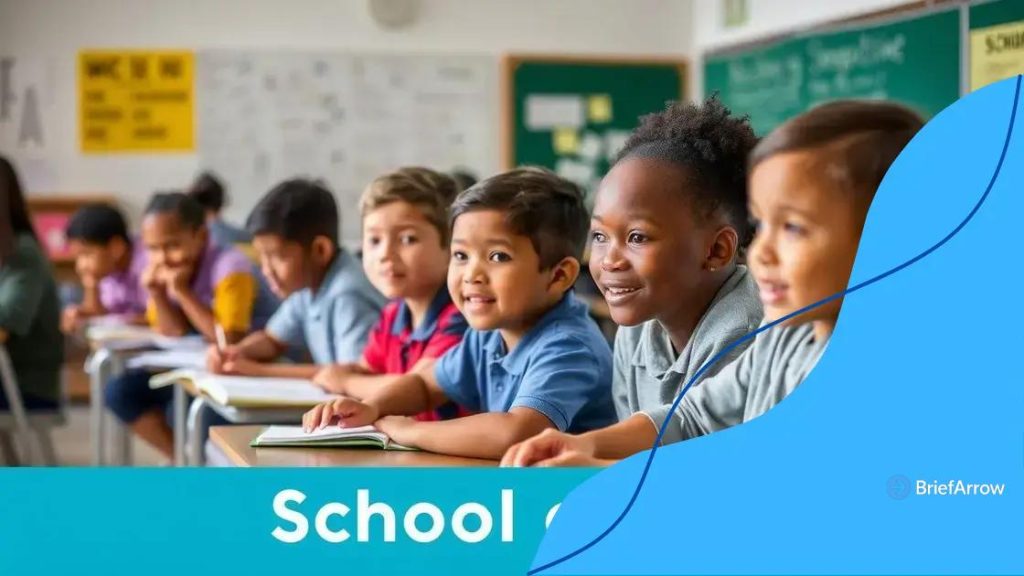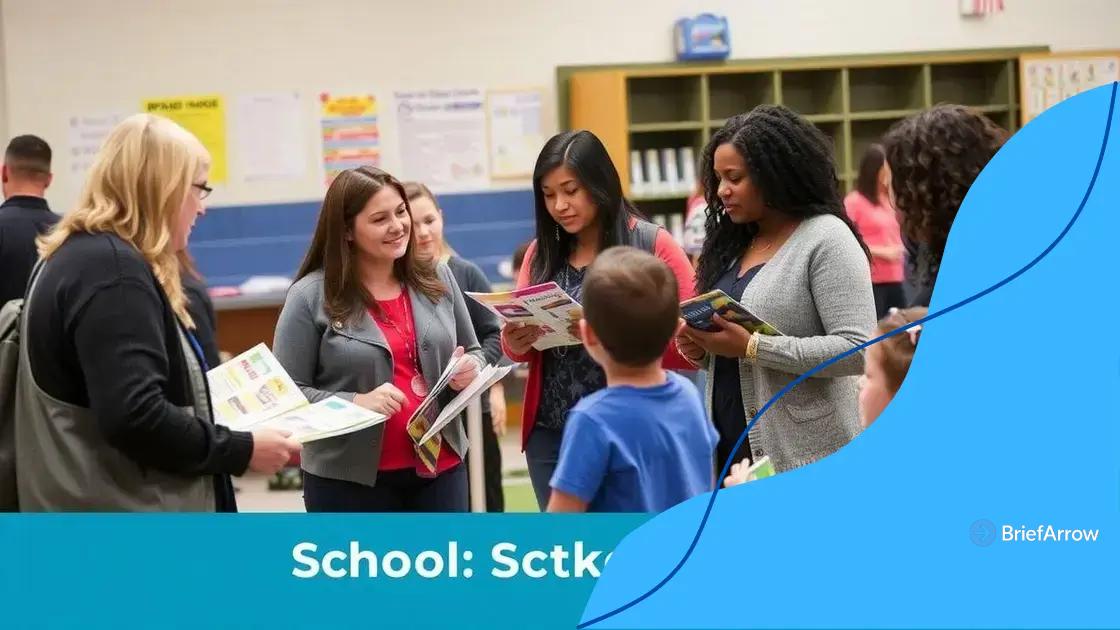State-level debates on school choice initiatives spark interest

Anúncios
State-level debates on school choice initiatives focus on increasing parental control and educational options while addressing challenges like equity and resource allocation.
State-level debates on school choice initiatives are igniting conversations across communities. Parents and educators alike are exploring how these choices can reshape educational landscapes. What do these initiatives mean for our children’s futures?
Anúncios
Understanding school choice initiatives
Understanding school choice initiatives is important for parents and educators who want to make informed decisions. These initiatives provide options for families, allowing them to choose schools that best meet their children’s needs.
When discussing school choice, it’s crucial to grasp how these programs function and the variety of options available. States have different approaches, ranging from charter schools to voucher systems.
Types of School Choice Options
Here are some common types of school choice initiatives:
Anúncios
- Charter Schools: Publicly funded schools that operate independently from the traditional school system.
- Vouchers: Financial assistance that allows parents to enroll their children in private schools.
- Magnet Schools: Public schools with specialized curricula aimed at attracting students.
- Open Enrollment: Policies that allow students to attend schools outside their designated districts.
Each choice has its own benefits. For example, charter schools often foster innovation, while vouchers provide financial support for families. Understanding these options helps parents make better decisions tailored to their children’s unique situations.
Many parents are eager to learn about how school choice impacts their communities. Conversations around these topics can spark community involvement and support for various educational models. Engaging in these discussions is vital, as it can influence policies and the future of education.
The impact of state-level decisions on local schools
The decisions made at the state level significantly influence local schools in various ways. These choices can shape funding, curriculum, and educational standards, affecting not only students but also teachers and the entire community.
For example, state policies regarding funding can determine how resources are allocated to different schools. Increased funding for certain programs can help improve facilities and provide better learning materials. Conversely, budget cuts can lead to larger class sizes and fewer resources available for students.
Effects on Curriculum
State-level decisions impact the curriculum that local schools implement. This means that educational standards and requirements may vary from one district to another:
- Core Standards: States may adopt different core standards, influencing what students learn in subjects like math and science.
- Testing Requirements: Changes in standardized testing can affect teaching methods and learning outcomes.
- Elective Courses: Availability of elective courses may vary based on state funding and policies.
Moreover, teacher evaluations and salary structures can also depend on state guidelines. These standards can directly affect teacher motivation and retention. When teachers feel supported by state policies, they are more likely to deliver effective instruction in the classroom.
Finally, the community’s role cannot be overlooked. Parents and local organizations often advocate for specific needs, making their voices heard in state-level discussions. Active engagement from the community can result in more tailored policies that directly benefit local schools.
Parent perspectives on educational options

Parents play a crucial role in shaping educational choices for their children. Their perspectives on educational options are influenced by many factors, including personal experiences, community values, and the specific needs of their children.
Understanding what parents consider when evaluating schools can help in creating better options. For many, academic performance is a top priority. They often look for schools with strong test scores and high graduation rates. However, other factors also matter significantly.
Key Factors Parents Consider
Here are some key factors that influence parents’ decisions:
- School Environment: Safety, support, and the overall atmosphere are vital for student success.
- Curriculum Quality: A well-rounded curriculum that encourages critical thinking and creativity is appealing.
- Extracurricular Activities: Opportunities for sports, arts, and community service can enhance a child’s school experience.
- Diversity and Inclusion: Many parents value schools that promote diversity and inclusivity.
The way parents share their experiences with neighbors and friends can also impact school choice. Word-of-mouth recommendations often carry weight in the decision-making process. Parents discuss the strengths and weaknesses of schools, helping others navigate their options.
Online resources have also become important. Websites and forums allow parents to compare schools and read reviews from other families. Many parents rely on these platforms to gather insights and find information about school performance, programs, and facilities.
Analyzing the advantages and disadvantages of school choice
Analyzing the advantages and disadvantages of school choice helps parents and policymakers understand its impacts on education. School choice offers different options, allowing families to select schools based on their unique educational needs and preferences.
One major advantage is increased parental control. When families can choose their child’s school, they can select an environment that aligns with their values and educational goals. This autonomy often leads to higher satisfaction among parents and students.
Advantages of School Choice
Here are some key benefits:
- Tailored Education: Students can attend schools that cater specifically to their interests or learning styles.
- Competition: Increased options can drive schools to improve their quality, as they must compete for students.
- Access to Specialized Programs: Choices may include schools that focus on arts, sciences, or other specialized curricula.
- Community Engagement: Parents often become more involved when they have a stake in their child’s educational environment.
Despite these benefits, school choice also has its challenges. Critics argue that it can lead to inequities in education. Families that are more informed or have greater resources may be better positioned to take advantage of school choice options.
Disadvantages of School Choice
Some notable drawbacks include:
- Resource Allocation: Schools that lose students may struggle with funding, impacting their ability to provide quality education.
- Segregation: School choice can lead to increased segregation by socioeconomic status or ethnicity.
- Limited Options: Not all communities have the same access to quality schools, creating disparities in educational opportunities.
- Confusion: The variety of choices can overwhelm parents, making it difficult to navigate options effectively.
Understanding these pros and cons helps stakeholders make informed decisions. Engaging in discussions around school choice can lead to solutions that benefit all students and families.
Future trends in school choice debates
Future trends in school choice debates suggest significant shifts in how education is perceived and accessed. As society evolves, so do the discussions surrounding which options work best for families and students alike.
One emerging trend is the increasing focus on personalized learning. Parents and educators are advocating for a system where students can tailor their education to fit their individual needs. This approach might mean more educational options outside the traditional classroom, such as online learning and hybrid models.
Growing Online Education Options
Online education has gained traction as a viable alternative. Families are exploring various digital platforms that provide flexible learning schedules:
- Virtual Schools: Many districts are establishing fully online schools as an option.
- Online Courses: Students can choose specific subjects from different providers to supplement their learning.
- Self-paced Learning: More programs offer courses that allow students to progress at their own pace.
These developments are changing the landscape of education. As technology continues to advance, many predict a rise in options not solely tied to geographic limitations.
Additionally, discussions around equity in school choice are becoming more pronounced. Advocates argue for policies that bridge gaps in accessibility, ensuring all families can benefit from various educational options. The aim is to create an equitable environment where school choice does not favor families with more resources.
Finally, the integration of social-emotional learning into educational frameworks is becoming a priority. Future school choices may emphasize well-being alongside academic achievement. Stakeholders increasingly recognize that a holistic approach to education supports students better.
FAQ – Frequently Asked Questions About School Choice Initiatives
What is school choice?
School choice refers to the various options available to parents and students for selecting educational institutions, including public, private, charter, and online schools.
What are the advantages of school choice?
Advantages include increased parental control, tailored education options, competition among schools which can lead to better quality, and access to specialized programs.
What challenges does school choice present?
Challenges include potential inequities in access to quality schools, resource allocation issues, and the risk of increased segregation among student populations.
What future trends can we expect in school choice debates?
Future trends may involve a greater focus on online education options, personalized learning approaches, and an emphasis on equity to ensure all students have access to quality education.